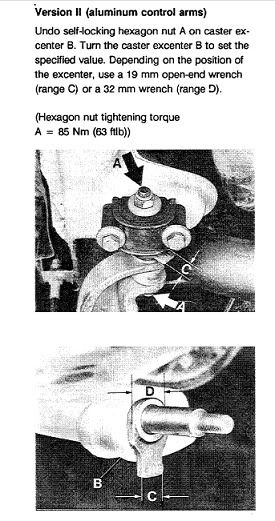Hi,
I can't give you any definitive answers - I'm still experimenting myself. Also, levels of acceptable compromise tend to be rather subjective.
I run:
KW v3 with 25.5 rear torsion bars, 26.8mm fr ARB, 19mm 3-way rr ARB.
My experience from trying different settings on my 944 is as follows:
Ride Height/Pitch:
Height: Lowest end of the factory settings for a 968 with M030.
- Front caster bolt face below wheel center = 157mm
- Rear torsion bar ctr below wheel center = -7mm (i.e. above wheel ctr)
This is the lowest set by the factory for cars with alu wishbones (to my knowledge), so should hopefully be ball-joint and bump steer freindly. I also run 205/50/15 track tyres - These drop the ride height by an extra 25mm on top of the above settings.
Pitch: Flat (spirit level on the sills - gave 50:50 corner weighting diagonally across the axles with little adjustment)
--------------------------------
Toe:
Front - parallel to slight toe in (typical for most rwd cars I think...)
The opposite would be the case for a fwd car (parallel to slight toe out), as the body imparts a rearward thrust trying to toe the wheels in. But a sports car like the 944 is reasonably tightly bushed, so front toe-change under load should be relatively small.
Rear - parallel
Or alternatively, if you don't mind sacrificing sharp turn-in for a stable rear and some mild scrub, opting for some toe-in may help to counter the tendency of the vw IRS to toe-out under load (so several people have commented to me).
--------------------------------
Camber:
1-2° negative on both axles
For ultimate grip the ideal would be to set the angle such that in the hardest turns the tyre contact patch remains square to the road surface. With a normal road tyre this could be around 2°neg, rising to as much as 3-5° for stickies.
Taking this approach feels great on-track when the car is loaded-up. In the middle of the corner, with the car taking a set, it feels a bit like there is an imaginary hand helping to hold the car on line.
The downside I found is when the car returns to the road and much lower cornering forces and more subtle steering inputs are employed. Go too mad on the camber here and you may find the steering a little too light and vague around the straight ahead. Also the car will be inclined to dart around with an alarming eagerness. This can be particularly disconcerting at speed on the motorway "" while sneezing, for example[&o].
--------------------------------
Caster:
3-4°
If you can stand heavier steering around town, I found increasing the caster to be an effective way of achieving a road/track compromise without extreme camber angles. More caster angle effectively increases the rise in negative camber due to steering angle - thus camber is there when you need it, allowing a lower cambersetting.
--------------------------------
A milder approach - and perhaps a good starting point if you are using road tyres - would be to select the more sporting end of the factory settings for camber and caster. This should retain nice road manners combined with good performance for occasional track action.
















